Research Article - (2025) Volume 8, Issue 2
The Climate /Carbon Conundrum: Should Carbon Dioxide Emissions Be Reduced or Allowed to Rise Steadily?
2Agro-Climatic Consulting, Winnipeg, Manitoba, Canada
Received Date: Mar 10, 2025 / Accepted Date: Apr 04, 2025 / Published Date: Apr 24, 2025
Copyright: �©2025 Madhav Khandekar, et al. This is an open-access article distributed under the terms of the Creative Commons Attribution License, which permits unrestricted use, distribution, and reproduction in any medium, provided the original author and source are credited.
Citation: Khandekar, M., Garnett, R. (2025). The Climate /Carbon Conundrum: Should Carbon Dioxide Emissions Be Reduced or Allowed to Rise Steadily?. Earth Envi Scie Res & Rev, 8(2), 01-07.
Abstract
The ongoing debate on climate change and an urgent need to curb worldwide CO2 , has reached a feverish pitch. Various environmentalist groups, policymakers and climate specialists are calling for urgent action to curb (CO2 ) emissions in order to avoid catastrophic consequences of future warming of the earth’s climate. Numerous climate organizations of “Western Nations (alternately “Rich Nations”) have developed elaborate plans to curb carbon dioxide emissions by allocating extensive funding to reduce emissions. These suggestions are often referred to as “Climate Action Plans”.
Keywords
Agro-Climatic Consulting, Winnipeg, Manitoba
Introduction
The ongoing debate on climate change and an urgent need to curb worldwide CO2, has reached a feverish pitch. Various environmentalist groups, policymakers and climate specialists are calling for urgent action to curb (CO2) emissions in order to avoid catastrophic consequences of future warming of the earth’s climate. Numerous climate organizations of “Western Nations (alternately “Rich Nations”) have developed elaborate plans to curb carbon dioxide emissions by allocating extensive funding to reduce emissions. These suggestions are often referred to as “Climate Action Plans”. The focus of these Climate Action Plans is based on the basic tenet that an increase in COâ?? emissions leads to the warming of the earth’s climate setting off a domino effect by an increase in weather extremes, leading to economic damages to the infrastructure and human life. There are several issues in the present climate change debate which are not well analyzed nor fully understood especially due to large uncertainties associated with many of the issues. It is imperative that these issues be examined closely, in the light of current state of the earth’s climate for developing balanced and sound climate policies. In the next section, a brief synopsis of the global warming science is provided. This is followed by a discussion on global temperature variations in conjunction with CO2 variations over periods of historical and geological times. The link, or absence of it, between climate warming and CO2 levels is discussed, focusing on several uncertainties. Also discussed is, the basic fact that warming of the earth precedes an increase in CO2 concentrations. Finally, the beneficial impacts of higher levels of CO2 on world agriculture and forestry are highlighted to bring out the main theme of this paper which is, “that CO2 is good for humanity and it’s increase in the environment outweighs any possible harmful impact that has been projected by the media and by various scientific publications”.
The Debate on Global Warming
The debate, warming of the earth’s climate due to worldwide human activity and associated increase in carbon dioxide concentrations in the earth’s environment began soon after publication of a landmark paper by Roger Revelle, an eminent US geophysicist [1]. The paper discusses carbon dioxide exchange between the oceans and the atmosphere and the increase in atmospheric carbon dioxide due to worldwide human activity and its possible impact on the earth’s climate. A key phrase used in the paper was that “humans are carrying out a large-scale geophysical experiment through worldwide industrial activity that could lead to a build-up of CO2 larger than the rate of CO2 production from volcanoes” This key phrase became the pivot for environmentalists and climate activists who have been persistently calling various governments and policymakers to reduce CO2 and associated industrial activity. Additionally, environmental groups focused their attention on fossil fuel (coal/natural gas/gasoline) producers as the primary culprits of producing more COâ?? in the environment. A general consensus ensued amongst environmental groups that fossil fuels are the major producers of CO2 and that it was the most important Greenhouse Gas (GHG) linked to the warming of the earth’s climate. Strangely enough, environmental groups have ignored the most important greenhouse gas in the environment namely water vapor, whose concentration varies considerably from one region to next. The typically, water vapor amount of just 2% is considered to be a very high value, representing a very moist atmosphere. It is important to note here that the current concentration of COâ?? at about 420 ppm-(parts per million) by volume, which is just 0.04% of the atmosphere. Figure 1 shows the present concentration of CO2 at about 420 ppm, by volume; also shown in this Figure is satellite-derived temperature of the lower atmosphere. Thus, a CO2 concentration of just 0.04% is minor, compared to that of a moist atmosphere with concentration of about 2%, which is fifty times more than current CO2 levels in the atmosphere. It is noteworthy that there is now a growing debate on the role of water vapor and its various phases in terms of low to mid to high level cloud cover on the earth’s climate [2]. The continued interest and concern over warming of the climate due to human activity led to the creation of a UN Climate Body the IPCC (Intergovernmental Panel on Climate Change) established in 1988. The IPCC was tasked to provide periodic information on world’s climate and future impacts on various nations. In one of their earliest documents on the science of climate change, the IPCC included a phrase that “the balance of evidence suggests a discernible human influence on climate [3].” This sacramental phrase caused considerable controversy among atmospheric scientists, environmentalists and policymakers leading to commentaries and documents [4,5]. For additional discussion on this global warming debate see also [6]. This debate has continued to resonate among most western nations leading to various climate action plans; there is also a rising growth of climate activists in most Western Nations who have put undue pressure on Governments of various nations to push for emission reduction. The IPCC has been holding annual gatherings called COP (Committee of Parties) meetings around November of each year to discuss the latest state of the climate science and determine additional measures to limit future (COâ??) emissions.
The Paris Climate Treaty 2015
This Paris meeting was an important landmark where an increase in temperature of 1.5 0C was established as the threshold temperature. It was argued that an increase in global mean temperature above 1.5 0C since the Industrial Revolution would be catastrophic for most world nations; In particular, that many Island nations in the South Pacific Ocean were identified as becoming vulnerable to the risk of higher sea levels and catastrophic losses. A special report SR1.5 was produced in which the IPCC once again, emphasized an urgent need reduce worldwide COâ?? emissions. The IPCC has continued to hold COP meetings every year around the month of November; these meetings have become an important forum for a large number of climate scientists, climate activists and many executives of multi-national corporations. The main objective of these annual COP meetings is to discuss the progress of emission reduction and make plans for additional reduction based on the latest state of climate change science. These meetings have now become a powerful impetus for curbing emissions in order to avoid a possible ‘climate catastrophe/climate emergency’ in the future. The fear of a climate emergency has been pushed by most environmentalists and climate activists. In reality, there is no climate emergency (see the website: www.climate.com) .
Green Energy Initiative
In last ten years, there has been more and more emphasis on switching to green energy since the conventional fossil fuel energy is identified as being the major producer of CO2 causing climate warming. Among the major sources of Green Energy are: a) large wind turbines with hundreds of tall wind mills erected to extract wind energy for power generation, b) large solar energy farms using millions of solar panels being built and designed to generate solar energy and c) envisioned hydro-electric power dams as an alternative to fossil fuel-based energy. The major thrust of these green energy initiatives is to develop alternatives to fossil fuel and to curb worldwide (COâ??) emissions. This approach has become very challenging in terms of developmental costs and environmental impacts such as millions of birds killed by wind turbines and large solar farms being harmful to human health. Readers are referred to a recent long commentary by Ms. Judith Curry [7].
Net ZERO by 2050
Net zero by 2050 is now the new narrative in the climate debate. The basic tenet in this narrative is development of the global pathways to world energy where the CO2 levels will remain small. It is argued that this goal of Net Zero by 2050 would help maintain the global mean temperatures below the 1.5C as stipulated in the Paris 2015 climate treaty. As of now, only a handful of nations have agreed to these net-zero targets; further, the net-zero agenda could cost world economies a whopping 240 trillion dollars, according to the Swiss Reinsurance Company Ltd. Besides, there are large uncertainties about the possible outcome of such enormously expensive plans on earth’s climate and any possible reduction in weather extremes and subsequent harmful impacts on world humanity and economy. In view of these and many other issues, the future and utility of the ‘Net Zero by 2050’ agenda is in considerable doubt at present.
Which Comes First?
Does warming of the climate precede the increase in CO2 level or vice-versa? This basic argument has not as yet been settled, however the general consensus amongst scientists is that the earth’s climate warms first (by mechanisms that are not fully understood) and that leads to an increase in CO2 levels. Several historical and geological records reveal a definite lag of several hundred years between warming of the climate and rise in CO2 levels. The well-known Vostok Ice Core data in Antarctica show a lag of 800 years or more between warming and the rise in COâ?? level [8]. On a shorter scale of last 50 to 60 years, temperature precedes COâ?? rise. Ocean surface temperature changes impact land surface temperatures. The latest satellite data (Figure 1) reveals the temperature variations for last 40 years or so. The graph shows several peaks coinciding with major El Nino events (sea surface warming in the central and east equatorial Pacific Ocean) of the last 40 years, while small dips in temperature changes associated with La Nina (sea surface temperature cooling in the central and east equatorial Pacific). What is most notable is the fact that CO2 rise has had NO impact on global mean temperatures in the last 40 years or more.
On Benefits of More COâ??
The basic premise of this publication is to document the beneficial impacts of higher levels of COâ?? on world humanity. Interestingly enough, this important issue has been all but neglected in the current climate debate. There is now a sizable body of literature showing rising CO2 levels bring a substantial increase to world agricultural production. An important experimental study FACE (Free Air Carbon Dioxide Experiment) was conducted several years ago whereby rising levels of COâ?? were introduced in large plots of vegetation to monitor the growth response of these vegetation and subsequent increase in grain yields. [9]. Similar experiments have been conducted by others, such as Craig Idso (refer to various documents on COâ?? science). These experiments have demonstrated substantial growth of plants with CO2 levels as high as 500 to 750 ppm. The benefits of rising levels of COâ?? on various grains like wheat, rice, corn etc. are documented in several studies. Several schematics showing beneficial impacts of COâ?? are presented below: These graphs amply demonstrate the steady growth of various grains with increasing levels of COâ??. Other recent studies show similar results, namely a steady increase in the growth of worldwide cereal production over last 25 years [10]. The UN Agency FAO-Food and Agricultural Organization (based in Rome, Italy) provides periodic estimates of world grain production. The FAO states that latest cereal production (wheat, rice and corn) has been 2840 mln tons Figure 4 reveals how cereal yield has increased by over 200% between 1961 and 2023. Further, many other studies show that increased COâ?? helps plants resist drought, intense heat, pollution and other environmental stresses (Google search: Our World in Data, Agriculture production 2023). Pertinent to World Forestry, increasing levels of COâ?? are making world forestry greener and richer, as evidenced by several satellite photographs of NASA, USA. Figures 2, 3, 4, 5, and 6 show the beneficial effects of additional COâ?? on plant life including crops, grains, cereals and forestry. It is of interest to note that the greening of forestry is realized in tropical as well as in high-latitude regions: In particular, the Boreal Forests of high-latitude regions of Canada and in Alaska show spectacular growth and have overcome deleterious impacts of forest fires in spring and summer. The beneficial impact of higher levels of COâ?? on world forestry is estimated to be several trillions of dollars; this beneficial impact significantly outstrips any deleterious impacts of increased levels of COâ?? on earth’s climate, either at present or in future. Once again, there is very little discussion or debate in various social media on this important issue. The current climate debate in the media and in scientific community appears to be focused solely on carbon dioxide emission reduction, with total disregard to the benefits of higher levels of CO2 levels.
Concluding Remarks
The primary focus of our paper is to bring out this important issue of the benefits of higher levels of COâ?? on the world community, as against possible harmful impacts (by way of increasing weather extremes). The above discussion amply demonstrates the positive and beneficial impact of more COâ?? in the environment. This enormous beneficial impact of rising levels of COâ?? has not been adequately debated among various nations’ policymakers and/ or related climate change action plans. There is an urgent need to openly debate the benefits versus possible harmful impacts of increasing levels of COâ?? on world humanity. Such a debate must also include discussion on the utility (futility?) of reducing future emissions at enormous costs. Based on the presentation above, we conclude that “emission levels of COâ?? should be allowed to rise steadily over next 25 years to reach a value of 500 ppm or more. A steady increase in worldwide COâ?? emissions would have enormous benefits to world humanity” [11,12].
One final comment: LET US EMBRACE CARBON DIOXIDE! IT IS THE STAFF OF LIFE!
Acknowledgements: This short paper has been prepared at the invitation of the Managing Editor Ms. Stella. One of the authors (MK) wishes to thank his wife Mrs. Shalan Khandekar for providing technical assistance while preparing the manuscript.
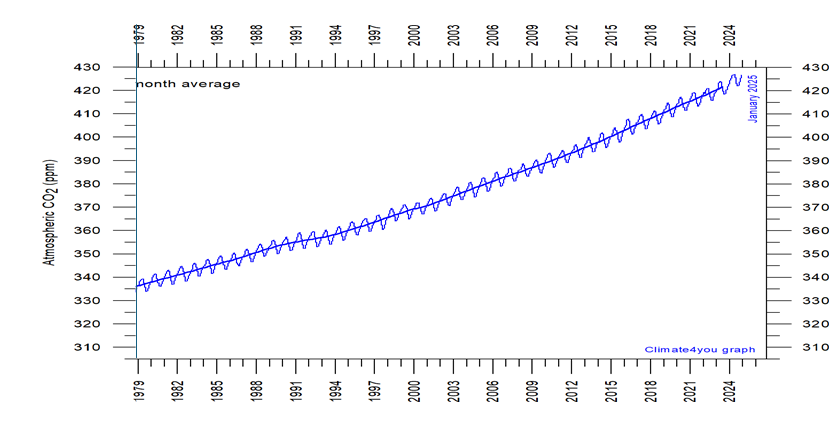
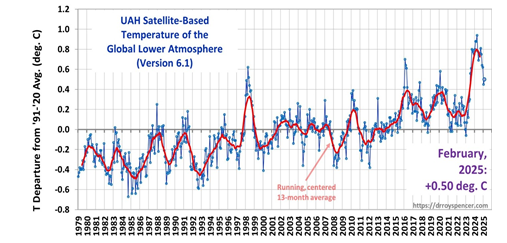
Figure 1: Variation in Atmospheric CO2 Levels Since 1979, In Conjunction with Satellite-Derived Temperature of Lower Atmosphere: (Credit: Dr Roy Spencer University of Alabama Huntsville USA): Note Some the Peaks in Global Mean Temperature Coinciding with Major El Nino Events—Ex. 1998; 2016-17: 2024.

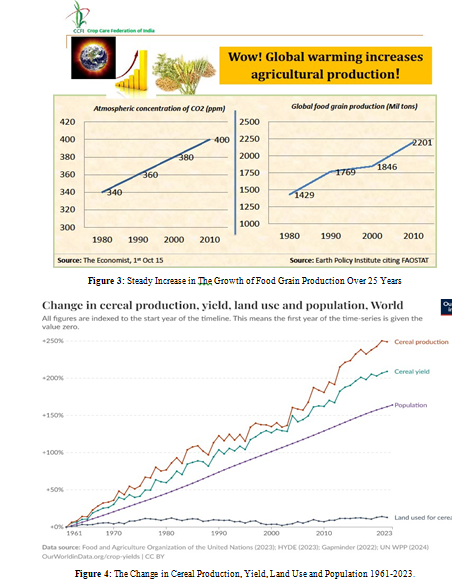
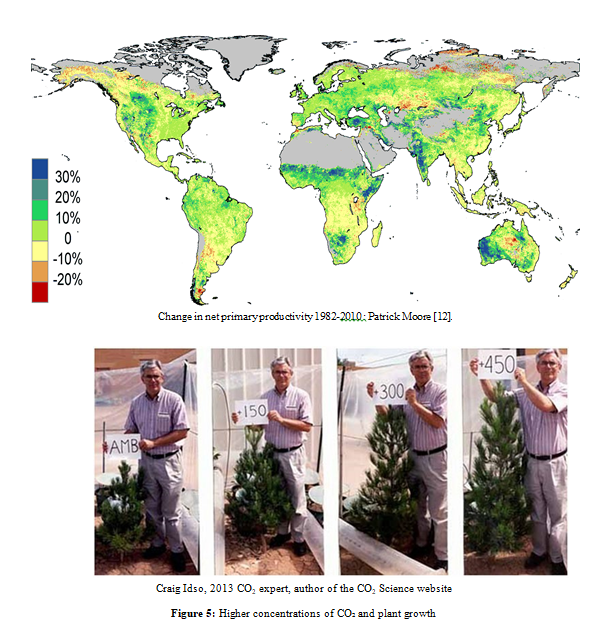
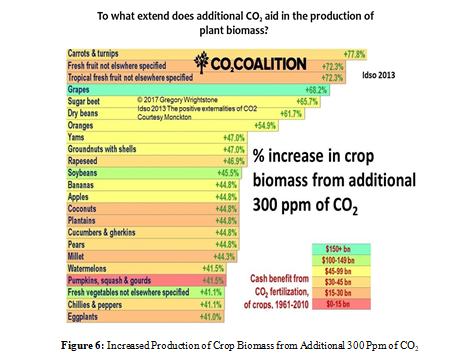
References
1. Revelle, R., & Suess, H. E. (1957). Carbon dioxide exchange between atmosphere and ocean and the question of an increase of atmospheric CO2 during the past decades. Tellus, 9(1), 18- 27.
2. Svensmark, H., & Friis-Christensen, E. (1997). Variation of cosmic ray flux and global cloud coverage—a missing link in solar-climate relationships. Journal of atmospheric and solar- terrestrial physics, 59(11), 1225-1232.
3. Houghton, J. T. (Ed.). (1996). Climate change 1995: The science of climate change: contribution of working group I to the second assessment report of the Intergovernmental Panel on Climate Change (Vol. 2). Cambridge University Press.
4. Masood, E. (1996). Sparks fly over climate report. Nature, 381(6584).
5. Seitz, F. (1996). A major deception on global warming. Wall Street Journal, 12, A16.
6. Khandekar, M. L., Murty, T. S., & Chittibabu, P. (2005). The global warming debate: A review of the state of science. Pure
7. Curry, Judith. (February 25, 2025). Commentary on Green Energy Initiatives in her web-blog Climate Etc.
8. Petit, J. R., Jouzel, J., Raynaud, D., Barkov, N. I., Barnola, J. M., Basile, I., ... & Stiévenard, M. (1999). Climate and atmospheric history of the past 420,000 years from the Vostok ice core, Antarctica. Nature, 399(6735), 429-436.
9. Hughes, A. M., Khandekar, M., & Ollier, C. (2014). About Face!: Why the World Needs More Carbon Dioxide; The Failed Science of Global Warming. Two Harbors Press USA.
10. Goklany. (2021). Impacts of climate change: Perception vs Reality. Report 46, GWPF-Global Warming Policy Forum UK, p.43.
11. Humlum, Ole. (2025). Climate4U; Weather and Climate Summary for February.
12. Moore, P. (2016). The positive impact of human CO2 emissions on the survival of life on earth. Frontier Centre for Public Policy.


